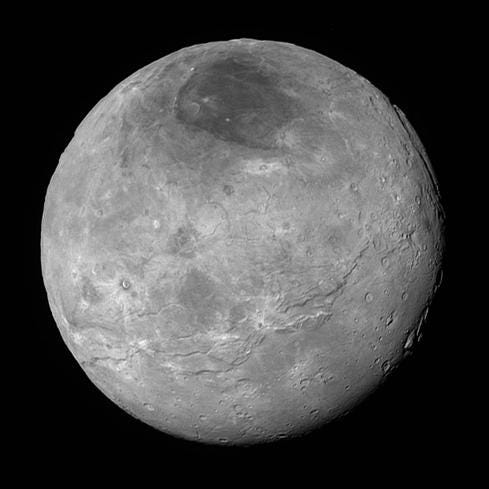NASA's New Horizons Reveal Charon's Violent Past
The most recent high-resolution images from NASA's New Horizons probe reveal surprising details of Pluto's largest moon, Charon, including massive canyons.


NASA's New Horizons Transmits New Pluto, Charon Images
NASA's New Horizons Transmits New Pluto, Charon Images (Click image for larger view and slideshow.)
NASA's mission to the outer reaches of the Solar System, New Horizons, has already dazzled scientists and the general public alike with stunning photos of the planet Pluto, and now the space agency is turning its attention toward Charon, Pluto's largest moon.
High-resolution images of the Charon, which were taken in July and transmitted to Earth on Sept. 21, provide indications of a surprisingly complex and violent history.
These images reveal details of a belt of fractures and canyons just north of the moon's equator, including a great canyon system -- four times as long as the Grand Canyon -- that stretches more than 1,000 miles across the entire face of Charon and likely around to the moon's far side.
"It looks like the entire crust of Charon has been split open," John Spencer, deputy lead for Geology, Geophysics and Imaging (GGI) at the Southwest Research Institute, wrote in an Oct. 1 statement. "With respect to its size relative to Charon, this feature is much like the vast Valles Marineris canyon system on Mars."
These faults and canyons indicate a titanic geological upheaval in Charon's past.
Another interesting feature New Horizons may have discovered are plains south of the Charon's canyon that could have been formed by cryovolcanism, a kind of cold volcanic activity.
The plains have fewer large craters than the regions to the north, indicating that they are noticeably younger. The massive canyon could mean the entire surface of Charon cracked open at one point, the result of an internal ocean freezing over.
"We thought the probability of seeing such interesting features on this satellite of a world at the far edge of our solar system was low," Ross Beyer, an affiliate of the New Horizons GGI team from the SETI Institute and NASA Ames Research Center, wrote in a statement. "But I couldn't be more delighted with what we see."
Charon, which is 754 miles across, lacks a color palette as diverse as Pluto's, its most striking feature being the reddish north polar region, informally named Mordor Macula.
Higher-resolution Charon images and composition data are still to come as New Horizons transmits data, stored on its digital recorders, over the next year.
The spacecraft is currently 3.1 billion miles from Earth, with all systems healthy and operating normally, the NASA statement stated.
[Read about NASA's Discovery programs.]
The mission to Pluto has been a resounding popular success for NASA and has as well delighted scientists who had previously relied on guesswork and blurry photographs when trying to analyze the farthest planet in our Solar System.
For months New Horizons has been sending back images and information about Pluto and its moons, revealing a complex world of color and topography.
The latest images of Pluto's surface show a multitude of previously unseen topographic and compositional details, including a vast rippling landscape of peculiar, aligned linear crests that have taken New Horizons team members by surprise.
NASA also recently made headlines with an incredible discovery closer to home. This week, the space agency announced that it had evidence that water -- the key to life -- was currently flowing across the surface of Mars.
About the Author
You May Also Like






